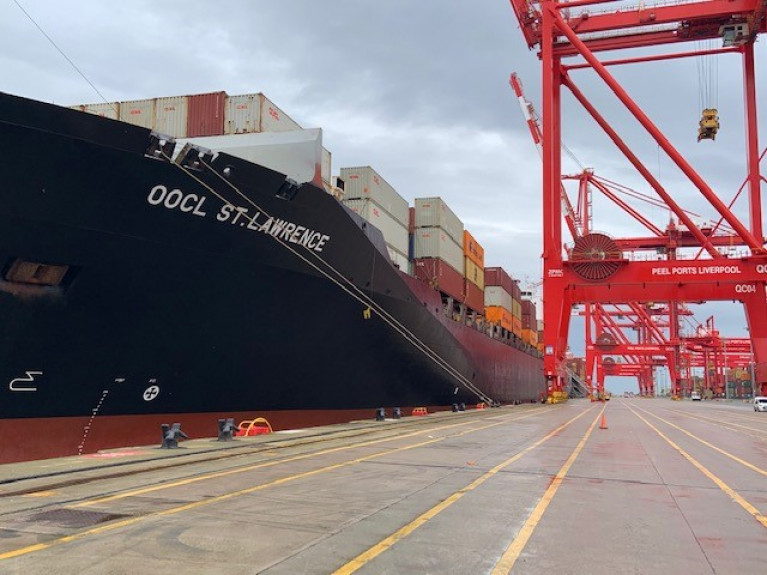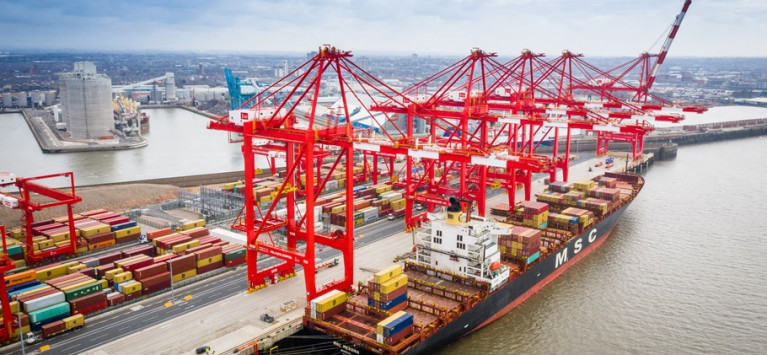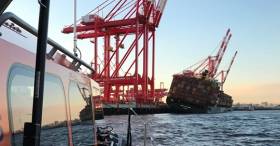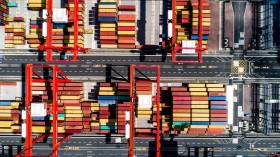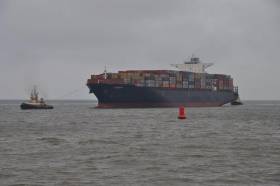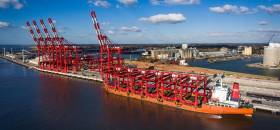Displaying items by tag: Liverpool2
Liverpool2's Second Phase Is Now Operational With Increased Capacity
The Port of Liverpool, owned by Peel Ports Group, has welcomed four new operational cantilever rail-mounted gantry (CRMG) cranes opening up an additional 15 acres of yard capacity as part of the £400m Liverpool2 project.
As the UK’s only west-facing deep-sea terminal, the multi-million expansion of Liverpool2 is in partnership with global terminal business, Terminal Investment Limited Sarl (TiL). Once completed it will provide global shipping companies reliable access to major import and export centres at the heart of the UK, to further increase capabilities and support increased demand.
David Huck, Managing Director at Peel Ports said:This significant project milestone demonstrates our continued investment in our customers and response to the Port of Liverpool’s growth trajectory as we increase our capacity and market share further.
The majority of the UK and Ireland live closer to the Port of Liverpool than to Felixstowe, London and Southampton, and this represents a catchment of over 35 million people.
The Port of Liverpool’s strategic location provides reliable access to major import and export centres at the heart of the UK, and an unrivalled connectivity to Ireland via our Irish Sea Hub.
Intended to help increase throughput and productivity at the port, the new cranes join 12 existing CRMGs and eight ship-to-shore (STS) cranes at Liverpool2, all of which were supplied by leading Chinese manufacturer, Zhenhua Heavy Industries Co (ZPMC) and delivered in phase one of the project.
From mid-September 2021, work on the third and final phase of the landside project is expected to be fully commissioned.
This will see an additional five acres of yard capacity and another six CRMG’s come online, which will total 10 CRMG’s and 20 acres of yard capacity in this second phase. This will be supported by over 150 new skilled jobs on Merseyside, with already 90 new recruited, trained and deployed this year.
Across the Irish Sea at the Port of Liverpool, the owners Peel Ports Group have welcomed an additional five cantilever rail-mounted gantry (CRMG) container shipping cranes that arrived at the UK port from China.
The delivery which was completed last week forms part of the next phase of growth at Liverpool2, the Merseyside port’s deep-water container terminal (which last month Afloat adds broke its own volume handling record twice).
Produced by leading Chinese manufacturer, Zhenhua Heavy Industries Co (ZPMC), the five new cranes are the first of two deliveries in 2021, which will complete the set of 22 CRMG cranes operating as part of the £400 million Liverpool2 project, and will provide additional capacity for growing volumes of cargo.
Ready for installing and commissioning, the arrival of this consignment marks the end of a 46 day journey of over 11,831 nautical miles from Shanghai, China. Each crane measures 35 metres in height with a weight of around 500 tonnes. Once completed, the site will have a total of eight STS and 22 CRMG cranes.
David Huck, Managing Director, Peel Ports Group said: “The dynamism and strength of the business gives us the confidence to continue to grow and invest. Throughout 2021, future-proofing will be at the forefront of our business model, driving forward with planned investments in our people, processes and technology.
“We are on course to achieve our ambitious growth plans to drive UK container market share to 20% by 2025. Liverpool2 is already one of the world’s most modern shipping terminals and we have no plans of slowing down any time soon. This recent delivery is testament to this and adds to three additional ship-to-shore cranes already delivered into live operations in December 2019.”
As one of the most operationally efficient and modern terminals in Northern Europe, the deep-water terminal offers ‘future-proof’ facilities, giving global shipping companies reliable access to major import and export centres at the heart of the UK.
David added: “The combination of Brexit-related changes and the impetus provided by COVID-19 has highlighted the vulnerability of supply chains to disruption, prompting a significant number of businesses to look at bringing more activity back to the UK.
“Working closely with the world’s leading shipping lines, we hope to encourage more services to the Port of Liverpool to help alleviate some of the pinch points on supply chains that have previously relied on Southern ports. Improving supply chain resilience could help to support the UK Government’s levelling up agenda by rebalancing economic activity away from the South towards areas in the North.”
Peel Ports Group, in conjunction with its partner global terminal business, Terminal Investment Limited Sarl (TiL), is continuing to develop the deep-water terminal which includes the multi-million expansion at Liverpool2, to further increase capabilities and support increased demand.
Once completed, the £400m container terminal will be capable of handling the largest ships in the world, whilst supporting the UK haulage sector via the very latest landside automated gates and vehicle booking systems.
Work on this second phase of the landside project is expected to be fully completed in the summer 2021 and will be supported by over 150 new skilled jobs on Merseyside.
Record Broken Twice For Highest Container Volume from Single Ship at Port of Liverpool
Across the Irish Sea at the Port of Liverpool’s deep water shipping container terminal at 'Liverpool2' located on the banks of the Mersey, is where the facility broke a record for the second time this year.
Containership MSC Tamara had docked and exchanged 5,956 TEUs, the highest number seen from a single vessel in Liverpool which took place earlier this year.
The vessel part of MSC’s new Turkey - Liverpool service, includes calls in Turkey, Spain, Portugal, France and the UK (Liverpool).
The volume of 5,956 TEUs exceeds the current record held at the Port of Liverpool, which stood at 5,460 TEUs when that first record occured in March.
The last 12 months have been a turning point for many supply chains and this has been achieved in the context of a market that has been significantly impacted by changes in global supply chains, the COVID-19 pandemic and Brexit. Its arrival signifies the current strength of the Port of Liverpool on the global trading stage.
In 2016 owner Peel Ports Group, invested £400m into the container terminal enabling it to handle the largest ships in the world, whilst supporting the UK haulage sector via the very latest landside automated gates and vehicle booking systems.
As one of the most operationally efficient and modern terminals in Northern Europe, the deep-water terminal offers ‘future-proof’ facilities, enabling global shipping companies reliable access to major import and export centres at the heart of the UK.
This is the port’s huge deep-water terminal which Afloat adds is located on the waterfront as distinct to part of the docks system.
According to Peel Ports, the giant gantry cranes at Liverpool2 stand 92m which is considerbly higher than London's Trafalgar Square Christmas Tree (20m). The unique festive cargo as Afloat previously reported was imported as a gift of the Norwegian Government to the UK.
This involved freight ferry operator DFDS transport the Norwegian Spruce across the North Sea to Immingham and then taken by road to be installed at the capital landmark.
Containership Giant Moves to Liverpool2 For Europe-Canada Service
Containership operator Orient Overseas Container Line (OOCL) in the UK is to move its Liverpool operations for its Europe-Canada trade to the port’s deepwater container terminal Liverpool2.
The new vessel [to the route] has a capacity 67% greater than the OOCL Belgium, which it is replacing. The 294-metre OOCL St Lawrence has a capacity of 5,024 TEUs (twenty-foot equivalent units).
OOCL has also confirmed that Liverpool2 will be a permanent call, as part of a rotation including Montreal, Bremerhaven, Antwerp and Le Havre.
More on this story reports The Business Desk.
Afloat adds OOCL St. Lawrence made its maiden call to the English north-west port on the Irish Sea with a call which took place on 29 September and departed last Thursday bound for Montreal. The 2005 built containership will be the first 'Panamax' vessel to serve the trans-Atlantic route.
In recent years Afloat has reported on another OOCL service out of the UK to Asia. This is based however on the east coast Port of Felixstowe from where vessels serving is the OOCL Hong Kong which when launched in 2017 was then the largest 'box-boat'.
The leadship of the 'G' -class carries 21,413 TEU is featured in a more recent report from earlier this year.
Across the Irish Sea from Dublin Port is the Port of Liverpool’s deep water container terminal, Liverpool2 where recently a new record was broken at the north-west England port.
The record goes to containership MSC Federica which berthed last month to exchange 5,452 TEUs, the highest number seen from a single vessel in Liverpool since the terminal opened in 2016.
The containeship is part of operator, MSC’s Turkey-Canada service which has seen remarkable success and includes calls at Montreal, Liverpool, Sines, Valencia, Barcelona and Tekirdağ amongst other terminals. This service directly links Liverpool to the Far East.
Its arrival signifies the current strength of the UK port on the global trading stage. In 2016 the Port of Liverpool's owner Peel Ports invested £400m into the container terminal, enabling it to handle the largest ships in the world while maintaining other port operations and productivity levels as normal.
As one of the most operationally efficient and modern terminals in Northern Europe, the deep-water terminal offers ‘future-proof’ facilities, enabling global shipping firms’ reliable access to major import and centres at the heart of the UK.
David Huck, Managing Director at Peel Ports, said: “This record is a testament to the investment we’ve put in to ensure state-of-the-art technology, including our five ship to shore cranes (STS) and twelve cantilever rail mounted gantry cranes (CRMG) to help make our world-class staff as efficient as possible. At difficult times like these, businesses want to know that their supply chains are able to cope with the increased demand and this demonstrates that the Port of Liverpool is ready to meet their needs.”
Peel Ports, in conjunction with global terminal business Terminal Investment Limited Sarl (TiL), is continuing to develop the deep-water terminal.
The next phase of growth has seen the arrival of a further three STS cranes which are being commissioned and will soon see a further 10 CRMG cranes which will increase the capacity of the terminal significantly, making it capable of managing the unloading of two 380m vessels simultaneously.
Work on this second phase of the project has already started and is expected to be completed during 2021.
Crew from Lifeboat Capture Gut-Wrenching Footage As Containership tips Over at Liverpool2
Dramatic footage shows the moment lifeboat crews arrived to the scene where a container ship was tipping over reports Liverpool Echo.
The emergency services were called to assist at Liverpool2 in the early hours of Friday morning after the MSC Matilde began to tip over as it was docking.
Pictures taken on the docks showed the ship from Panama, which was reportedly carrying millions of pounds worth of goods, dangerously listing to the right but now, video taken on the water shows just how bad the situation was.
A spokesperson for the RLNI confirmed that Hoylake 's volunteer crew were paged in the early hours to offer support to the vessel alongside Crosby Coastguard.
A spokesperson for the Maritime and Coastguard Agency said: "HM Coastguard was contacted by Peel Ports VTS at around 2.25am today (24 May) to report that a container vessel was listing just outside Gladstone Dock on the River Mersey."
For much more including photos and footage click this link to the Liverpool docks story.
Liverpool2 Port Ready to Ease Retailer Concerns As Supply Chain Blockage Continues in UK
#Ports&Shippping - A UK ports operator, Peel Ports has said its Liverpool2 deep-water container terminal is ready to help clear the growing backlog of imported goods into the country caused by IT implementation problems in the south-east port of Felixstowe, Essex.
According to Peel Ports, October is typically when retailers prepare stock levels for the Christmas rush, with the sector also gearing up for Black Friday on November 23.
Felixstowe, the largest shipping terminal in the UK, has suffered serious backlogs in cargo loading and unloading since June, after an unsuccessful roll-out of a new IT system that shows little sign of improvement. Incoming vessels can currently be waiting at anchor offshore for six days.
While some shipping operators have diverted cargos to other south-east terminals – Southampton and London Gateway – these are also feeling the impact caused by delays at Felixstowe. The backlog is now reportedly causing a knock-on impact on European carriers and terminals.
Liverpool2 was a £400 million investment by Peel Ports to create a deep-water container terminal capable of handling all vessels in the global fleet.
Haulage congestion – and subsequent premiums being levied by road transport firms – has added to the difficulties caused by the Felixstowe IT failure. Booking a haulage slot can currently take two weeks in Felixstowe and Southampton. During this time, containers have to remain on the port, where they are incurring rent charges.
However, approximately 60% of containers which enter UK ports are destined for the West Midlands or further north, making Liverpool a more efficient port of entry – it would also remove an estimated one million trucks from the road each year, and more than 1600 freight trains from the rail network, reducing related diesel emissions.
In addition, 35 million people in the UK and Ireland – more than half of the total population – live closer to Liverpool than south-east container ports.
Major shipping lines MSC and Maersk are already using Liverpool2 for UK containerised cargo and the Port of Liverpool has experienced an 8.7% year-to-date growth in all containerised traffic.
Mark Whitworth, chief executive of Peel Ports, said: “The arduous situation in the UK retail sector is well-documented. The last thing it needs is to be unnecessarily hobbled by a logistics crisis with no end in sight. This is an avoidable situation and we would urge shipping lines, forwarders and cargo owners, to talk to us about how we can get their cargo moving again rather than having to face a delay that shows no sign of abating.
“Peel Ports is ready to welcome cargo destined for the UK as well as shipments bound for international destinations from the UK, and we have ample capacity to do so. Liverpool2 was developed specifically for large deep-water cargo vessels. With a growing proportion of the UK’s logistics and warehousing facilities based in the North and the Midlands, there are multiple benefits to containers arriving in Liverpool.”
Liverpool2 Receives New Trans-Atlantic Container Services
#Ports&Shipping - Liverpool2, Peel Ports’ flagship deep-water container terminal, welcomed its largest regular caller to date when 2M (Maersk and MSC alliance) introduce a new transatlantic container service to the port that began yesterday.
2M is switching its TA2 service from Felixstowe to Liverpool on a temporary basis. At the same time, Maersk Line’s South American service, Colombia Express, will also start calling at the port of Liverpool, exporting UK goods to Newark.
Liverpool will be the final port of call for both weekly services as they head westbound across the Atlantic. The ships will load UK export cargo such as Scotch whisky, food products and trade machinery. The new services will also see the Port of Liverpool open up direct links with the US ports of Charleston and Savannah.
The TA2 and Colombia Express routes will use a range of vessels up to 8500 TEU. The larger vessels will call at Liverpool2 with smaller vessels using Royal Seaforth Container Terminal.
Earlier this year Peel Ports introduced a rail freight service directly from the Port of Liverpool in partnership with DB Cargo. It is now the only major UK container terminal to offer tri-modal connectivity, with road, rail and water, the Manchester Ship Canal, plus short-sea shipping.
#GiantCranes - The last batch of giant cranes for the Irish Sea's newest container terminal, the £400m Liverpool2 deep-water port development arrived by sea from China onto the River Mersey in recent days.
In May, Afloat reported on the first delivery from China of the cantilever rail-mounted gantry (CRMG) cranes that will be used at the biggest container terminal on the Irish Sea. The facility will cater for larger capacity and deeper-draft containerships.
Mark Whitworth, chief executive of Peel Ports, said: “These cranes are the final major piece of the infrastructure jigsaw as we approach the formal opening next month".
“Liverpool2, supported by our wider logistics offering and the port’s strategic location, will provide many shippers with a route to UK and Irish markets that helps them to cut costs, congestion and carbon emissions.”
The Chinese manufacturer ZPMC, also supplied the five ship-to-shore cranes and other CRMGs already on site, these six complete the set of 12 required for phase 1 of the terminal. Ultimately the site will have eight STS and 22 CRMG cranes as part of a £100m equipment investment.
Each of the cranes will be capable of performing an average of 20 moves per hour, with semi-automated control linked to the port’s new Navis N4 terminal operating system. They have a 40 tonne under-spreader capacity and a maximum container lift height above quay level of 21m under spreader (6+1 containers).
In August the cranes originally set off from Nantong on board the Zhenhua 8, passing south-east Asia, India, the Arabian Peninsula and through the Suez canal en route to Liverpool in a 49 day journey of over 20,000km (13,730 m, 11,930nm).






























